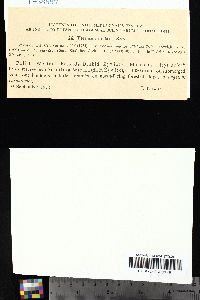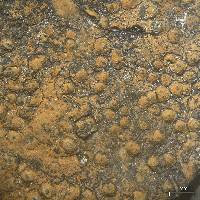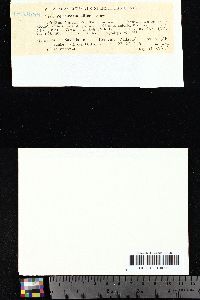
Consortium of Lichen Herbaria
- building a Global Consortium of Bryophytes and Lichens as keystones of cryptobiotic communities -
- Home
- Search
- Images
- Species Checklists
- US States: O-Z >
- US National Parks
- Central America
- South America
- US National Parks
- Southern Subpolar Region
|
|
|
|
Family: Verrucariaceae
[Lithoicea funckii A. Massal., morePyrenula funckii Spreng., Verrucaria collematodes f. funckii (A. Massal.) Servít, Verrucaria degenerascens Nyl. ex A.L. Sm., Verrucaria elaeomelaena f. silicicola Zschacke, Verrucaria nigrescens var. funckii (A. Massal.) Zwackh, Verrucaria silicea Servít, Verrucaria silicea f. coniocarpa (Zschacke) Servít, Verrucaria silicea f. silicea Servít] |
Nash, T.H., Ryan, B.D., Gries, C., Bungartz, F., (eds.) 2007. Lichen Flora of the Greater Sonoran Desert Region. Vol 3. Thallus: determinate, irregularly rimose, often forming large patches, thin (0.05-0.20 mm), becoming subgelatinous when wetted, with a thin, black basal layer or (partly) lacking, with or without a pale, narrow prothallus surface: pale to dark brown, orange-brown or brownish green, smooth anatomy: paraplectenchymatous throughout, with a dark pigmented uppermost cell layer; algal cells: 5-10 µm in diam., in vertical columns or irregularly distributed throughout the thallus Perithecia: almost entirely immersed in thallus, lying beneath the plane or ±bulging surface or in thalline warts with only the apex visible as black spot from above; exciple: 0.2-0.4 mm wide, colorless to brownish; involucrellum: reaching down to exciple-base level, contiguous with the exciple or somewhat extending beyond it with lower inner parts paler, slightly broadening towards base, of "Zellnetztyp"; periphyses 20-25 µm long, thin, partly furcate asci: clavate, 8-spored ascospores: hyaline, simple, ellipsoid, 18-25 x 9-11 µm, sometimes with a thin perispore Pycnidia: unknown Spot tests: all negative Secondary metabolites: none detected. Substrate and ecology: epilithic, on largely or permanently submerged siliceous rocks, upland World distribution: widespread in western Eurasia and North America Sonoran distribution: Arizona and Sonora. Notes: The separation of Verrucaria funckii from V. elaeomelaena (A. Massal.) Arnold is mainly substrate-based, the latter being strictly calcicolous. In addition to the ecological difference, V. elaeomelaena differs also in having larger, especially broader, spores. |
Powered by Symbiota





















